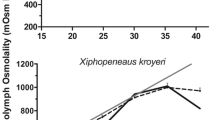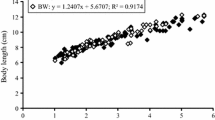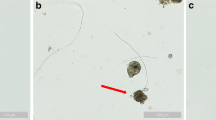Abstract
The ability to survive under extreme environmental conditions was studied in the adults of the heart sea urchin Echinocardium cordatum (Pennant). At seawater temperatures of 13.3 to 14.8°C and salinity of 33.2–33.4‰, being devoid of the possibility to burrow into the sand or eat, some sea urchins died on day 5 and all individuals had perished by the end of day 8. At a temperature of 19°C, the salinity tolerance range of adults was limited to 33–28‰. Only 30 to 20% of sea urchins transferred to a solid substrate survived for 7 days at a salinity of 33 to 24‰, but all of them perished toward the end of day 8.
Similar content being viewed by others
References
Baranova, Z.I., Phylum Echinodermata, Zhivotnye i rasteniya zaliva Petra Velikogo (Animals and Plants of Peter the Great Bay), Leningrad: Nauka, 1976, pp. 114–120.
Berger, V.Ya., On Adaptation to Fluctuating Salinity in Some Intertidal Mollusks of the White Sea, Solenostnye adaptatsii vodnykh organizmov (Salinity Adaptations of Water Organisms), Leningrad: Zoological Institute, USSR Academy of Sciences, 1976, pp. 59–112.
D’yakonov, A.I., Echinoderms (Echinodermata) of Syaukhu Bay, Sea of Japan, Trudy Gidrobiologicheskoi Ekspeditsii Zoologicheskogo Instituta AN SSSR, 1938, issue 1, pp. 425–498.
D’yakonov, A.M., On Capability of Echinoderms to Withstand Decrease of the Normal Oceanic Salinity, Dokl. AN SSSR, 1955, vol. 7, no. 2, pp. 373–374.
Kashenko, S.D., Issledovanie gruntov zaliva Vostok (Yaponskoe more) (Studies of Grounds in Vostok Bay, Sea of Japan), Manuscript deposited in VINITI, August 29, 1991, no. 3605-A91, 1991.
Skarlato, O.A., Bivalve Mollusks—Bivalvia, Zhivotnye i rasteniya zaliva Petra Velikogo (Animals and Plants of Peter the Great Bay), Leningrad: Nauka, 1976, pp. 95–107.
Buchanan, J.B., The Bottom Fauna Communities and Their Sediment Relationships off the Coast of Northumberland, Oikos, 1963, vol. 14, pp. 154–175.
Buchanan, J.B., The biology of Echinocardium cordatum (Echinodermata: Spatangoidea) from Different Habitats, J. Mar. Biol. Ass. U. K., 1966, vol. 46, pp. 97–114.
Féral, J.-P., Poulin, E., and Oubelkheir, K., Geographic and Genetic Differentiation of Echinocardium cordatum (Pennant)—The Current State of a Complex Questions: The Status of Echinocardium fenauxi (Péquignat), Echinoderms, San Francisco; Rotterdam: Balkema. 1998, pp. 647–649.
McBride, E.W., The development of Echinocardium cordatum, Part I: The External Features of the Development, Quart. J. Microsc. Sci., 1914, vol. 59, pp. 471–486.
Osanai, K., Handling Japanese Sea Urchins and Their Embryos, The Sea Urchins Embryo, Berlin; New York: Springer-Verlag, 1975, pp. 26–40.
Yamamoto, G., Habitats of Spats of the Scallop, Pecten yessoensis Jay, Which Turned to Bottom Life, Sci. Rept. Tohoku Univ., ser. IV, 1956, vol. 22, no. 3, pp. 149–156.
Author information
Authors and Affiliations
Additional information
Original Russian Text © S.D. Kashenko, 2006, published in Biologiya Morya.
Rights and permissions
About this article
Cite this article
Kashenko, S.D. Resistance of the heart sea urchin Echinocardium cordatum (Echinoidea: Spatangoida) to extreme environmental changes. Russ J Mar Biol 32, 386–388 (2006). https://doi.org/10.1134/S1063074006060101
Received:
Issue Date:
DOI: https://doi.org/10.1134/S1063074006060101




